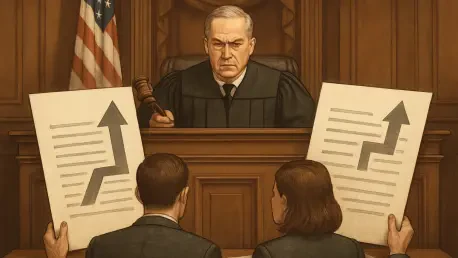What happens when a single presidential policy reshapes trillions of dollars in global trade, only to be struck down as unlawful by a federal court, sending shockwaves through markets and politics alike? This seismic clash between executive power and legal boundaries unfolded on August 29, when a federal appeals court ruled that President Donald Trump’s sweeping global tariffs violate the International Emergency Economic Powers Act (IEEPA). The decision has rattled markets, ignited political firestorms, and left businesses scrambling to adapt. This ruling isn’t just about tariffs—it’s about who truly controls the levers of trade policy in America. Dive into the details of a legal battle that could redefine presidential authority for years to come.
A Landmark Verdict Disrupting International Commerce
The Court of Appeals for the Federal Circuit delivered a stunning 7-4 decision, affirming a lower court’s finding that Trump’s expansive tariffs—dubbed “Trafficking Tariffs” and “Reciprocal Tariffs”—overstep the limits of executive power. These measures, affecting nearly all goods from most countries, were deemed unauthorized under the IEEPA, a law meant for emergency economic actions, not indefinite trade overhauls. The court’s ruling challenges the foundation of a policy that has altered supply chains worldwide, impacting everything from consumer prices to corporate bottom lines.
This verdict reverberates far beyond legal texts, striking at the heart of a contentious economic strategy. With trillions of dollars in trade hanging in the balance, the decision has sparked urgent questions about the separation of powers. The court delayed its mandate until October 14, keeping the tariffs temporarily intact and paving the way for a likely Supreme Court appeal. For now, the global trade landscape remains in limbo, caught between judicial restraint and executive ambition.
The Stakes of Trade Policy in a Tense Global Economy
Trump’s tariffs, implemented since early this year, have been a defining feature of his economic playbook, targeting nations from Mexico to China and beyond. They’ve driven up costs for businesses—reports estimate a 15% increase in import expenses for some sectors—and reshaped how companies source materials. Beyond economics, these policies have strained diplomatic ties, with trading partners threatening retaliatory measures that could further destabilize markets.
At its core, this ruling isn’t just about numbers; it’s a battle over authority. Does the president have the unilateral right to wield tariffs as a tool of national security, or must Congress hold the ultimate say? With global trade already fraught with tension—think ongoing disputes with the European Union and China—this legal outcome could either embolden or curtail executive reach, setting a precedent for how economic policy intersects with law in an interconnected world.
Unpacking the Judicial Reasoning Behind the Ruling
The majority opinion in the Federal Circuit’s decision hinged on a strict reading of the IEEPA, arguing that the law never intended to grant presidents carte blanche over long-term tariffs. The court emphasized that Congress, not the executive, holds constitutional authority over trade policy, and Trump’s actions—spanning unlimited duration and scope—crossed that line. This wasn’t a critique of tariffs as a concept but a rejection of their unprecedented scale without legislative backing.
Dissenting judges, however, painted a different picture, defending the president’s broad powers in foreign affairs. They pointed to historical precedents where executive authority was upheld in national security contexts, suggesting that the tariffs address critical economic threats. This split decision—7 to 4—underscores a deeper ideological rift over emergency powers, a debate that now seems destined for the Supreme Court’s docket as the administration prepares its next move.
Voices from the Frontlines: Experts and Political Reactions
Legal scholar Michael Lowell of Reed Smith’s Global Regulatory Enforcement Group offered a nuanced take, noting that the sheer breadth of these tariffs likely tipped the judicial scales. “A more targeted approach—say, tariffs on a single nation or product—might have avoided this pushback,” Lowell remarked. He also cautioned that the Supreme Court’s conservative lean could favor the dissent’s arguments, making the final outcome anyone’s guess.
Politically, the ruling has ignited a firestorm, with Trump taking to Truth Social to decry it as a “Radical Left” assault on American strength. He argued that the trillions collected through tariffs are vital for economic and military resilience, framing the decision as a betrayal of national interests. These contrasting views—legal precision versus political rhetoric—highlight the messy intersection of law and policy, where every stakeholder sees a different path forward.
Charting a Course Through Trade Uncertainty
For businesses ensnared in this legal quagmire, adaptability is critical. Lowell advises companies to meticulously document imports and tariff payments, preparing for potential refunds if the Supreme Court upholds the ruling. Firms using brokers must ensure paperwork is airtight to prevent customs snarls—a single error could delay shipments by weeks, costing millions in lost revenue for industries like manufacturing.
Policymakers, meanwhile, face mounting pressure to redefine the scope of emergency powers under laws like the IEEPA. Legislative reforms could emerge as a response, aiming to prevent future overreach while balancing national security needs. For importers, lawmakers, and everyday consumers, staying informed is the first step toward navigating a trade environment that remains unpredictable, with ripple effects likely to persist regardless of the judicial outcome.
Reflecting on a Defining Moment in Trade History
Looking back, the court’s decision on August 29 marked a pivotal clash between branches of government, challenging the unchecked use of executive power in trade policy. The temporary delay of the mandate until mid-October kept businesses on edge, while the looming Supreme Court battle promised to shape economic governance for decades. The voices of experts, politicians, and judges revealed a nation divided on how to wield economic tools in a globalized era.
As this saga unfolded, it became clear that preparation was paramount. Businesses were urged to shore up their records and brace for potential shifts, while policymakers had to grapple with crafting clearer legal boundaries. The path ahead demanded vigilance—whether through advocating for legislative clarity or monitoring judicial outcomes, stakeholders across the spectrum needed to stay engaged to mitigate the fallout of this historic ruling.









